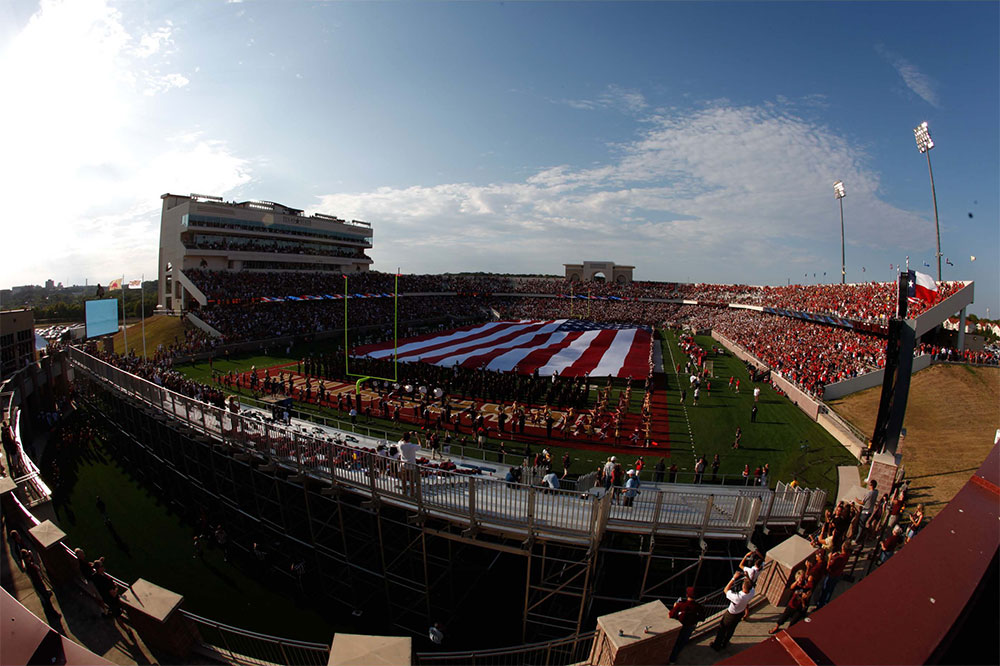Facilities & Directions

Bobcat Stadium was built in 1981 and is the home of Bobcat Football. With recent additions including the Jerry D. and Linda Gregg Fields West Side Complex and the North Side Complex, Bobcat Stadium has elevated to one of the best 30,000 seat stadiums in the country.
The End Zone Complex was completed and dedicated in 2002. The facility located in the south end zone of Bobcat Stadium houses the athletic program's football operations. The End Zone Complex also has a full service training center, meeting rooms and coaching staff offices.
In 2003, the playing field in Bobcat Stadium was named Jim Wacker Field to honor Texas State's former football coach and director of athletics. Wacker coached the Bobcat football team from 1979-82. His 42-8 record in the span is the highest winning percentage in school history. He led the Bobcats to back-to-back NCAA Division II national championships in 1981 and 1982. His 1982 team finished the season 14-0, and he was named College Division Coach of the Year by the American Football Coaches Association. He also served as director of athletics at Texas State (then Southwest Texas State) from 1998-01. He passed away on Aug. 26, 2003 after a lengthy battle with cancer.
BOBCAT STADIUM INCLUDES SEVERAL STATE-OF-THE-ART AMENITIES DONATED BY FAITHFUL BOBCAT FANS
- Jerry D. and Linda Gregg Fields Bobcat Stadium West Side Complex
- Mark and Linda Smith Ticket Office
- Linda Gregg Fields Strutters' Gallery
- Wallace & Lyla Dockall Football Meeting Room
- Dan Brown Football Meeting Room
- Subway Head Football Coach's Office
- Albert Gonzalez & Susan Angell Football War Room
- Tal & Leslie Milan Defensive Coordinator's Office
- Greg & Teresa Hagan Offensive Coordinator's Office
- Chuck Nash Strength & Conditioning Room
- J. Garland Warren Room
- Wells Fargo Stadium Terrace
The J. Garland Warren Room is located on the second floor and one of two major banquet rooms which are a part of Texas State athletics. In addition, the J. Garland Warren Room along with the Maroon and Gold Room at Strahan Coliseum play host to events of all kinds throughout the year.
In 2006, the Bill Miller Room was dedicated on the west side of the stadium in honor of legendary Football Coach and Athletic Director Bill Miller. Originally, the Bill Miller Room was used during every home football game to host Athletic Alumni functions but is now used as an academic study area for the Bobcat football program. Newly constructed in the southwest corner of Bobcat Stadium is the Pavilion which now hosts pre-game and halftime hospitality areas for the Bobcat Club and "T" Association on game days.
The capacity of the stadium is 30,000 with the addition of club seating and luxury suites in 2009, and 13,500 seats in 2012.
The Bobcat Stadium playing surface is FieldTurf Duraspine Pro turf system that was installed in 2010 and features maroon end zones and sidelines. Texas State was one of the first NCAA or NFL teams to use the FieldTurf Duraspine turf, which has a more durable artificial grass blade that is significantly softer than any other in the industry.
The stadium's video scoreboard manufactured by Daktronics of Brookings, S.D. in 2007, features two of the best resolution screens in the Sun Belt Conference. Additionally, new LED ribbon boards were added to the facility in 2012.
In 2012 the track was removed from Bobcat Stadium making it a football only playing facility.
In 2009 the Jerry D. and Linda Gregg Fields Bobcat Stadium West Side Complex opened to fans wanting to enjoy Bobcat Football in style. Featuring 15 luxury suites and a 450-seat club seating area this facility makes watching Bobcat football games the thing to do.
Original construction of Texas State University's Bobcat Stadium began in 1979 and was completed in August, 1981. The project also included the demolition of Evans Stadium and the addition of more than 2,000 parking spaces. The stadium was designed by Lockwood, Andrews & Newman of Houston and built by Kunz Construction Co. of San Antonio.
During its 25-year history, Bobcat Stadium has been a multi-use facility. It has been the home of the Texas Special Olympics, and site of scenes from the movie, "The Ringer", and the hit NBC TV show, "Friday Night Lights".
|
|
